Adaptive Quasi-Super-Twisting Sliding Mode Control for Flexible Multistate Switch
Abstract
1. Introduction
2. FMSS Nonlinear Control Design
2.1. FMSS System Architecture
2.2. FMSS Radiation Modeling
2.3. Coordinate Mapping and Control Law Solving
3. Construction of Adaptive Quasi-Super-Twisting Sliding Mode Controller
4. FMSS AQST-SMC Controller Design
4.1. AQST-SMC Voltage Outer Ring Design
4.2. AQST-SMC Current Inner Loop Design
5. Analysis of System Simulation Examples
5.1. AQST-SMC Performance Analysis
5.2. Dynamic Simulation Verification of FMSS System
5.2.1. Comparison of Simulations with Disturbed System Output Power
5.2.2. System AC Measured Voltage Amplitude Dips
5.2.3. Disturbance of System Electrical Parameters
5.3. Validation of Uacf Mode of Operation
6. Conclusions
Author Contributions
Funding
Data Availability Statement
Acknowledgments
Conflicts of Interest
Appendix A
References
- Chen, Y.; Tang, Z.; Weng, X.; He, M.; Zhang, G.; Yuan, D.; Jin, T. A novel approach for evaluating power quality in distributed power distribution networks using AHP and S-transform. Energies 2024, 17, 411. [Google Scholar] [CrossRef]
- Liu, Y.; Hu, J.; Shi, J.; Yang, B. Adaptive integrated control strategy for MMC-MTDC transmission system considering dynamic frequency response and power sharing. J. Electr. Eng. Technol. 2023, 147, 108858. [Google Scholar] [CrossRef]
- Ivic, D.R.; Stefanov, P.C. An extended control strategy for weakly meshed distribution networks with soft open points and distributed generation. IEEE Access 2021, 9, 137886–137901. [Google Scholar] [CrossRef]
- Mardanimajd, K.; Karimi, S.; Anvari-Moghaddam, A. Voltage stability improvement in distribution networks by using soft open points. J. Electr. Eng. Technol. 2024, 155, 109582. [Google Scholar] [CrossRef]
- Li, Z.; Ye, Y.; Wang, Z.; Wu, Y.; Xu, H. Integrated planning and operation evaluation of micro-distribution network based on flexible multistate switch interconnection. CES Trans. Electr. Mach. Syst. 2021, 36, 10. [Google Scholar] [CrossRef]
- Hou, Y.; Xu, Y.; Wang, Z.; Chen, X.; Cui, H. Research on application of three-port SNOP based on dual closed-loop control in the distribution network. In Proceedings of the IEEE International Conference on Smart Technologies and Management for Computing, Chennai, India, 2–4 August 2017; pp. 389–395. [Google Scholar] [CrossRef]
- Wang, Z.; Sheng, L.; Huo, Q.; Hao, S. An improved model predictive control method for three-port soft open point. Math. Probl. Eng. 2021, 2021, 9910451. [Google Scholar] [CrossRef]
- Peng, B.; Zhang, G. Coordination control strategy for three-port SNOP based on FCS-MPC. J. Eng. 2019, 2019, 1005–1010. [Google Scholar] [CrossRef]
- Aithal, A.; Li, G.; Wu, J.; Yu, J. Performance of an electrical distribution network with soft open point during a grid side AC fault. Appl. Energy 2018, 227, 262–272. [Google Scholar] [CrossRef]
- Li, Z.; Hao, Q.; Gao, F.; Wu, L.; Guan, M. Nonlinear decoupling control of two-terminal MMC-HVDC based on feedback linearization. IEEE Trans. Power Deliv. 2019, 34, 376–386. [Google Scholar] [CrossRef]
- Zhang, G.; Tang, B.; Shen, C.; Wang, T.; Xu, C.; Xia, Z. A strategy for suppression of voltage fluctuation on DC side when SOP port is unbalanced. Electr. Meas. Instrum. 2021, 61, 95–101. [Google Scholar] [CrossRef]
- Li, B.; Liang, Y.; Wang, G.; Li, H.; Ding, J. A control strategy for soft open points based on adaptive voltage droop outer-loop control and sliding mode inner-loop control with feedback linearization. Int. J. Electr. Power Energy Syst. 2020, 122, 106205. [Google Scholar] [CrossRef]
- Zhou, M.; Su, H.; Zhou, H.; Feng, Y.; Wang, D.; Cheng, J. Full-order sliding mode control strategy for soft open point. Proc. CSEE 2023, 43, 8622–8635. [Google Scholar] [CrossRef]
- Liu, Y.C.; Laghrouche, S.; Depernet, D.; N’Diaye, A.; Djerdir, A.; Cirrincione, M. Disturbance-observer-based speed control for SPMSM drives using modified super-twisting algorithm and extended state observer. Asian J. Control 2024, 26, 1089–1102. [Google Scholar] [CrossRef]
- Xu, Q.; Jiang, D.; Wang, Y.; Zhang, X.; Liu, J.; Chen, Y. Variable-step close-loop angle compensation method of PMSM rotor position estimation based on super-twisting sliding-mode observer using tangent reaching law. Energy Rep. 2023, 9, 356–361. [Google Scholar] [CrossRef]
- Maged, N.A.; Hasanien, H.M.; Ebrahim, E.A.; Tostado-Véliz, M.; Jurado, F. Optimal super twisting sliding mode control strategy for performance improvement of islanded microgrids: Validation and real-time study. Int. J. Electr. Power Energy Syst. 2024, 157, 109849. [Google Scholar] [CrossRef]
- Ghazi, G.A.; Al-Ammar, E.A.; Hasanien, H.M.; Ko, W.; Lee, S.M.; Turky, R.A.; Tostado-Véliz, M.; Jurado, F. Circle search algorithm-based super twisting sliding mode control for MPPT of different commercial PV modules. IEEE Access 2024, 12, 33109–33128. [Google Scholar] [CrossRef]
- Saadaoui, A.; Ouassaid, M. Super-twisting sliding mode control approach for battery electric vehicles ultra-fast charger based on Vienna rectifier and three-phase interleaved DC/DC buck converter. J. Energy Storage 2024, 84, 110854. [Google Scholar] [CrossRef]
- Çelik, D.; Ahmed, H.; Meral, M.E. Kalman filter-based super-twisting sliding mode control of shunt active power filter for electric vehicle charging station applications. IEEE Trans. Power Deliv. 2023, 38, 1097–1107. [Google Scholar] [CrossRef]
- Tiwary, N.; Naik, N.V.; Panda, A.K.; Narendra, A.; Lenka, R.K. A robust voltage control of DAB converter with super-twisting sliding mode approach. IEEE J. Emerg. Sel. Top. Ind. Electron. 2023, 4, 288–298. [Google Scholar] [CrossRef]
- Wang, F.; Yang, A.; Yu, X.; Zhang, Z.; Wang, G. Model-free predictive current control for three-phase Vienna rectifier based on adaptive super-twisting sliding mode observer. Trans. China Electrotech. Soc. 2024, 39, 1859–1870. [Google Scholar] [CrossRef]
- Pati, A.K.; Sahoo, N.C. Adaptive super-twisting sliding mode control for a three-phase single-stage grid-connected differential boost inverter based photovoltaic system. ISA Trans. 2017, 69, 296–306. [Google Scholar] [CrossRef]
- Hou, J.; Wang, Z.; Zhou, H.; Xu, H.; Wei, W. Soft open point control strategy based on super-twisting-full-order fast terminal composite sliding mode. Autom. Instrum. 2023, 3, 143–147. [Google Scholar] [CrossRef]
- Wang, Z.; Zhou, H.; Su, H. Disturbance observer-based model predictive super-twisting control for soft open point. Energies 2022, 15, 3657. [Google Scholar] [CrossRef]
- Ma, W.; Lü, Q.; Zhang, Y.; Zhang, K.; Han, J.; Li, M. Suppression strategy for fault current of flexible multi-state switch in distribution network fault state. Power Syst. Technol. 2021, 45, 4251–4258. [Google Scholar] [CrossRef]
- Zhang, K.; Wang, L.; Fang, X.; Zhang, K.; Han, J.; Li, M. High-order fast nonsingular terminal sliding mode control of permanent magnet linear motor based on double disturbance observer. IEEE Trans. Ind. Appl. 2022, 58, 3696–3705. [Google Scholar] [CrossRef]
- Li, P. Convergence of super-twisting algorithm based on quadratic-like Lyapunov function. Control Decis. 2011, 26, 949–952. [Google Scholar] [CrossRef]
- Levant, A. Sliding order and sliding accuracy in sliding mode control. Int. J. Control 1993, 58, 1247–1263. [Google Scholar] [CrossRef]
- Yang, H.; Bai, Y.; Chien, Y.R. Generalized super-twisting sliding mode control of permanent magnet synchronous motor based on sinusoidal saturation function. IEICE Electron. Express 2022, 19, 20220066. [Google Scholar] [CrossRef]
- Fu, K.; Yi, H.; Zhuo, F.; Li, S. Self-healing control strategy based on snop under severe fault condition. In Proceedings of the 2021 IEEE Sustainable Power and Energy Conference (iSPEC), Nanjing, China, 23–25 December 2021. [Google Scholar] [CrossRef]
- Li, X.; Liu, J.; Yin, Y.; Zhao, K. Improved super-twisting non-singular fast terminal sliding mode control of interior permanent magnet synchronous motor considering time-varying disturbance of the system. IEEE Access 2023, 11, 17485–17496. [Google Scholar] [CrossRef]
- Tripathi, V.K.; Kamath, A.K.; Behera, L.; Verma, N.K.; Nahavandi, S. Finite-time super twisting sliding mode controller based on higher-order sliding mode observer for real-time trajectory tracking of a quadrotor. IET Control Theor. Appl. 2020, 14, 2359–2371. [Google Scholar] [CrossRef]

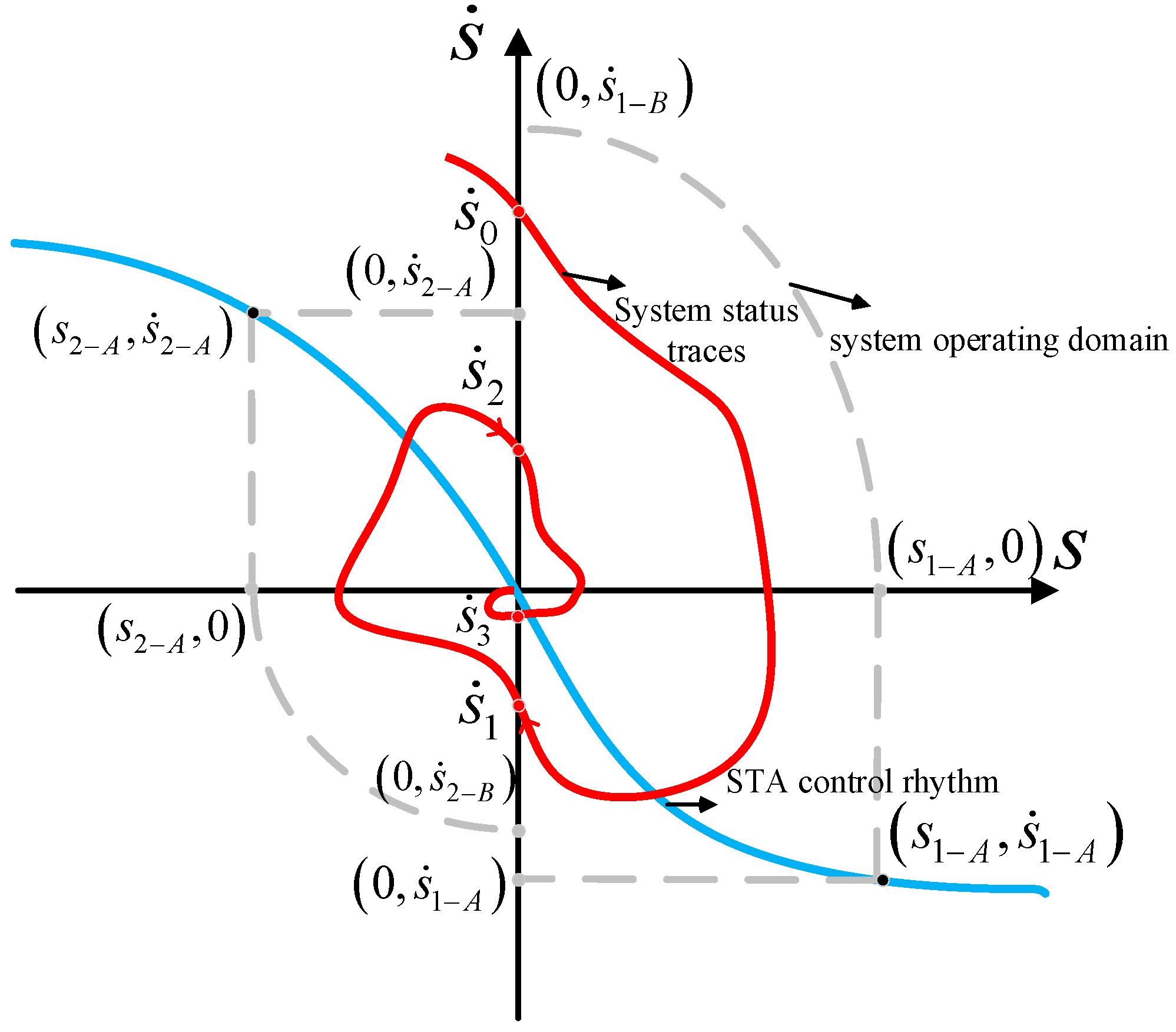



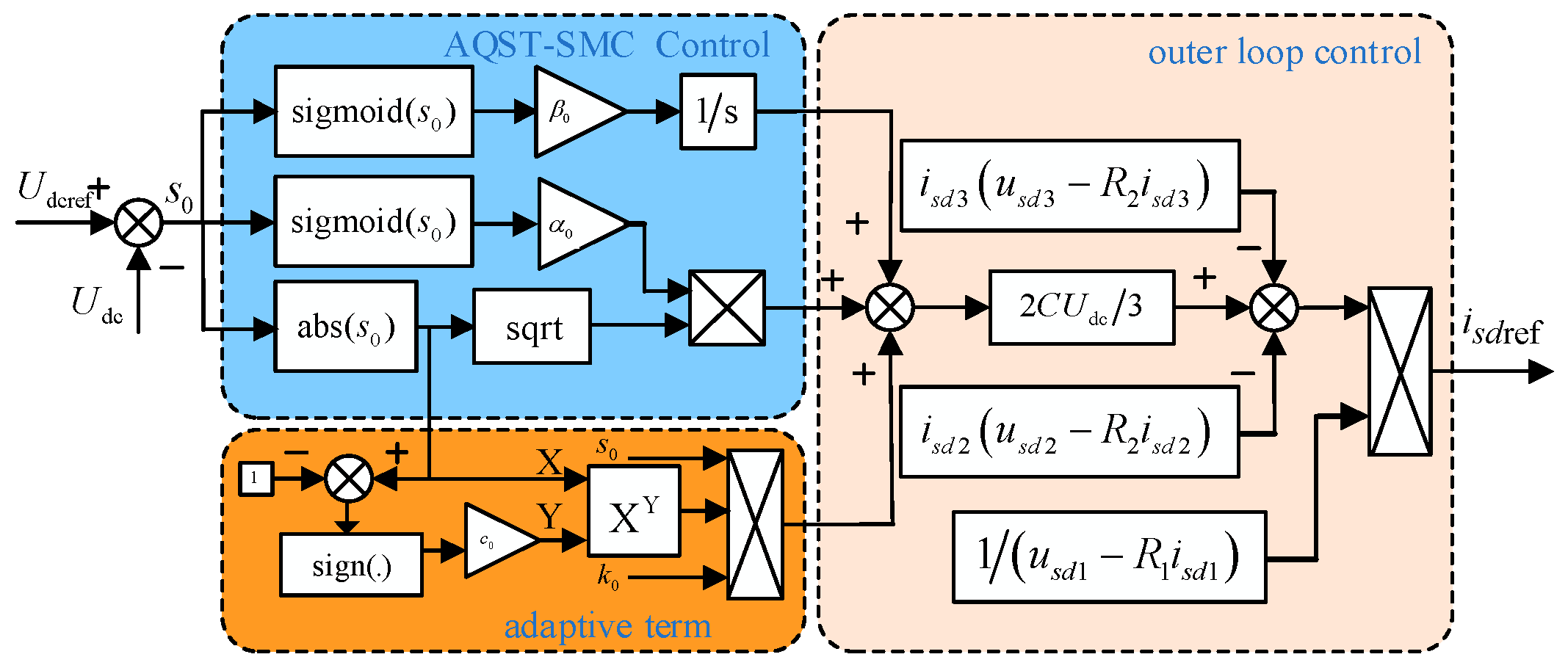
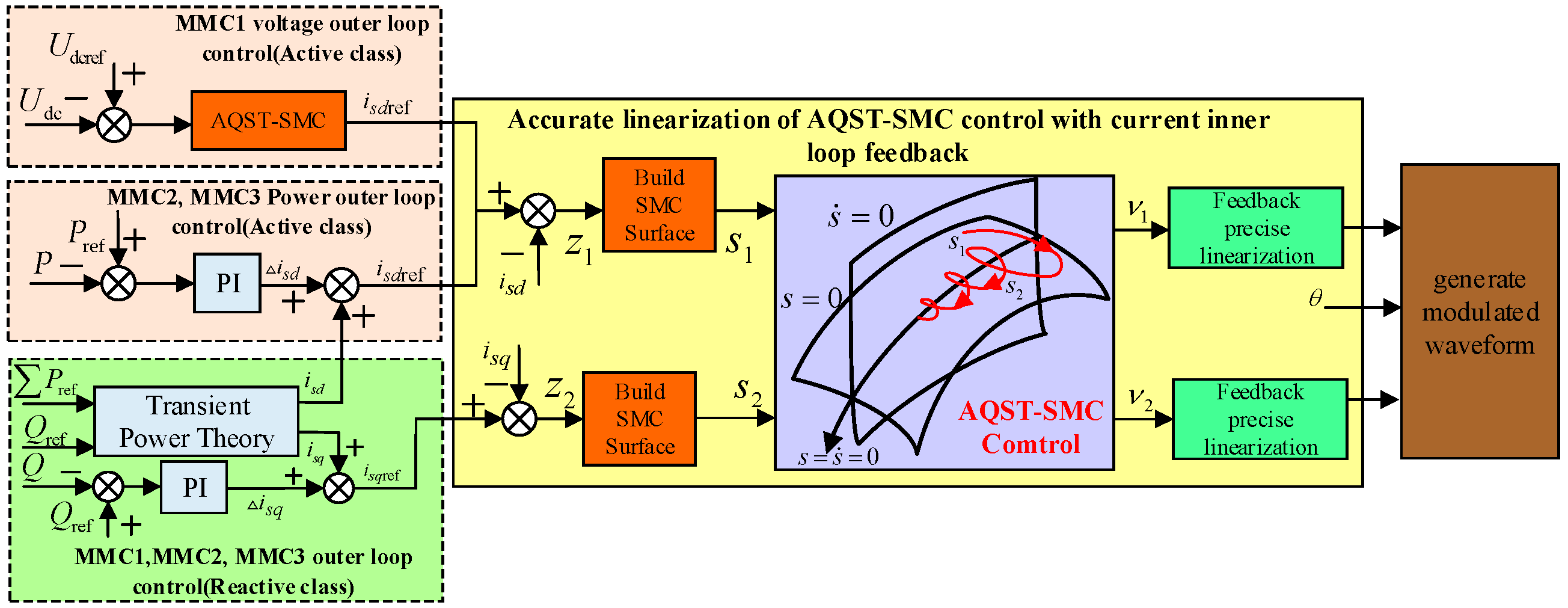

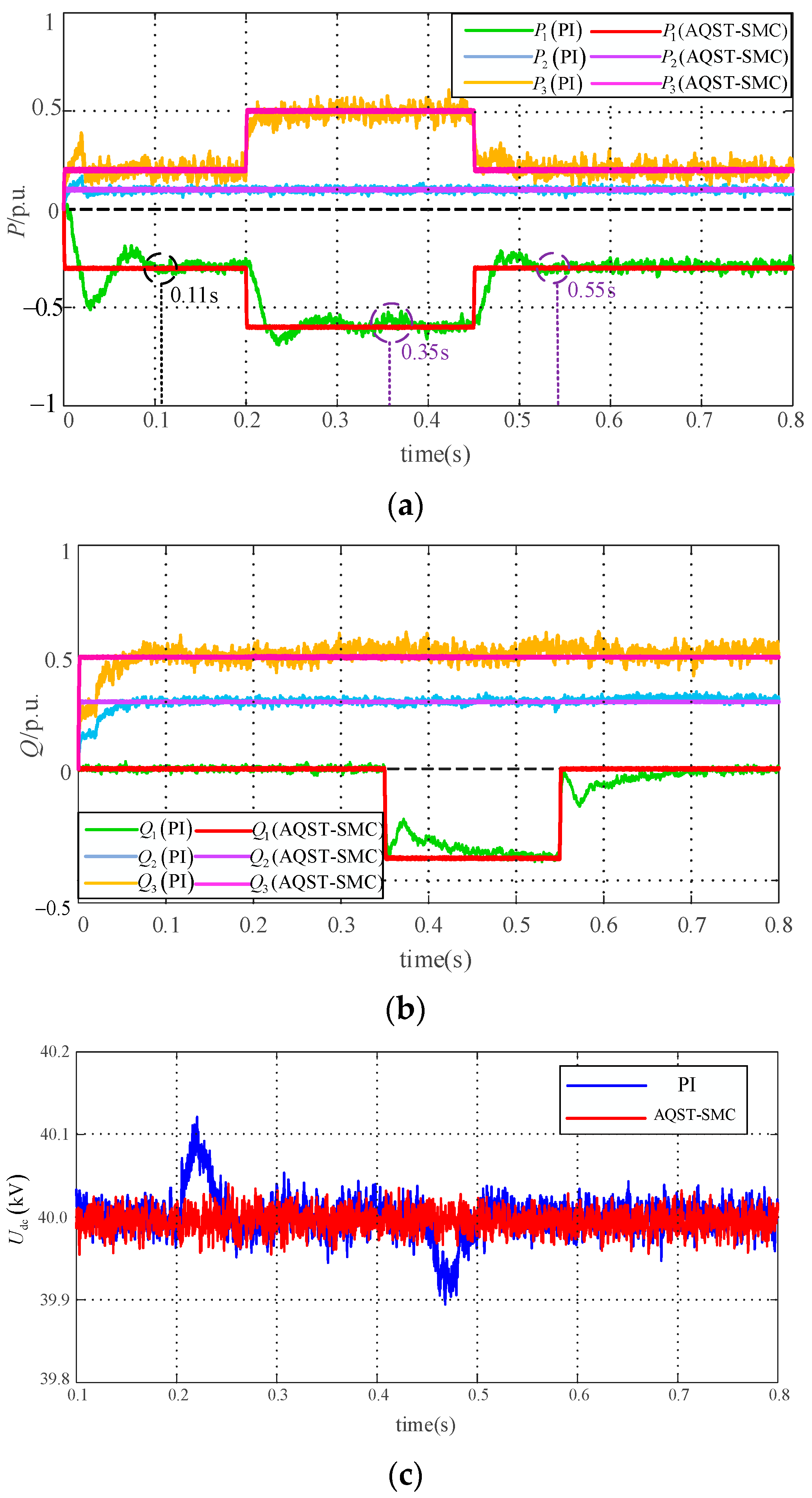
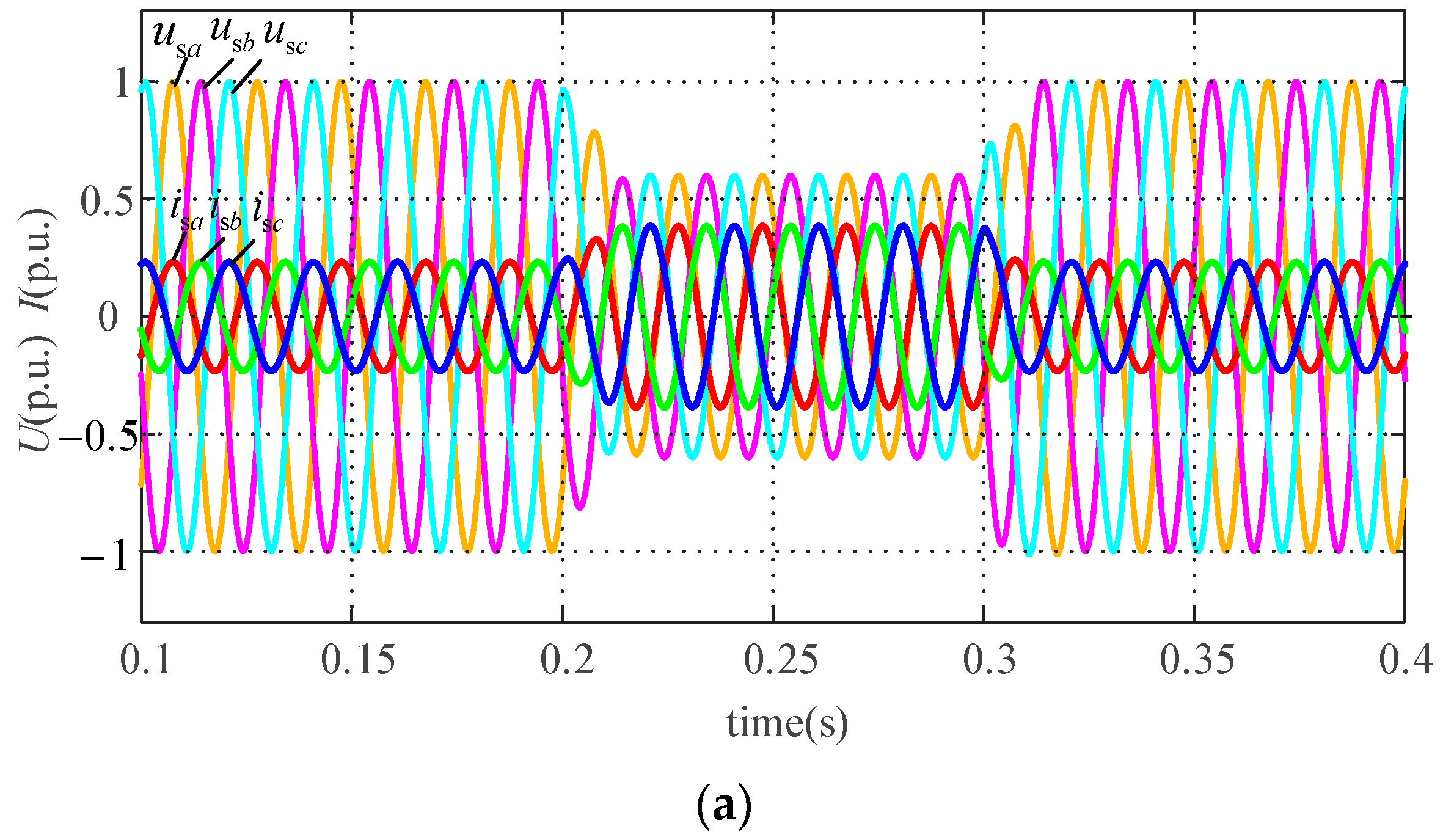
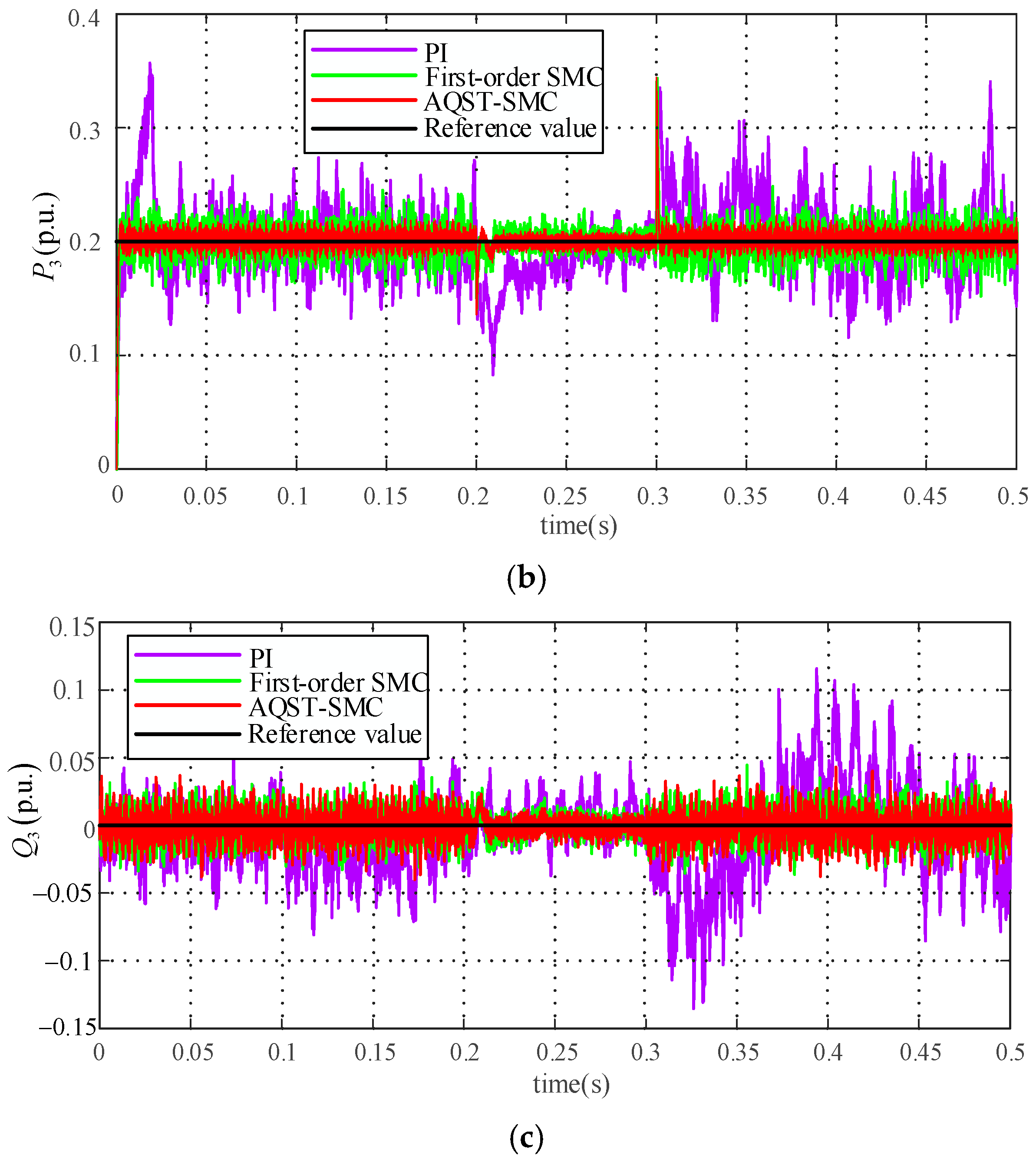
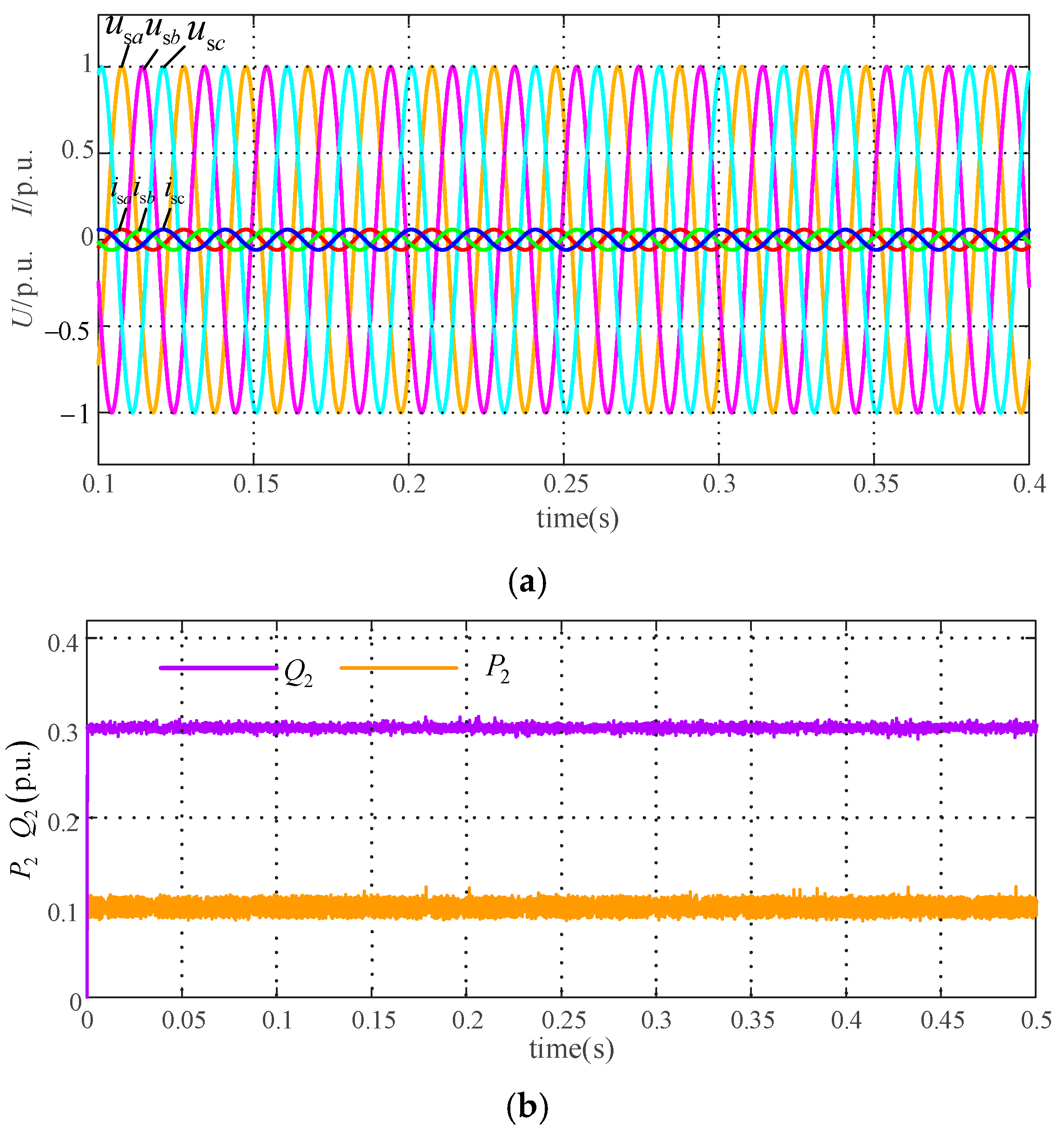

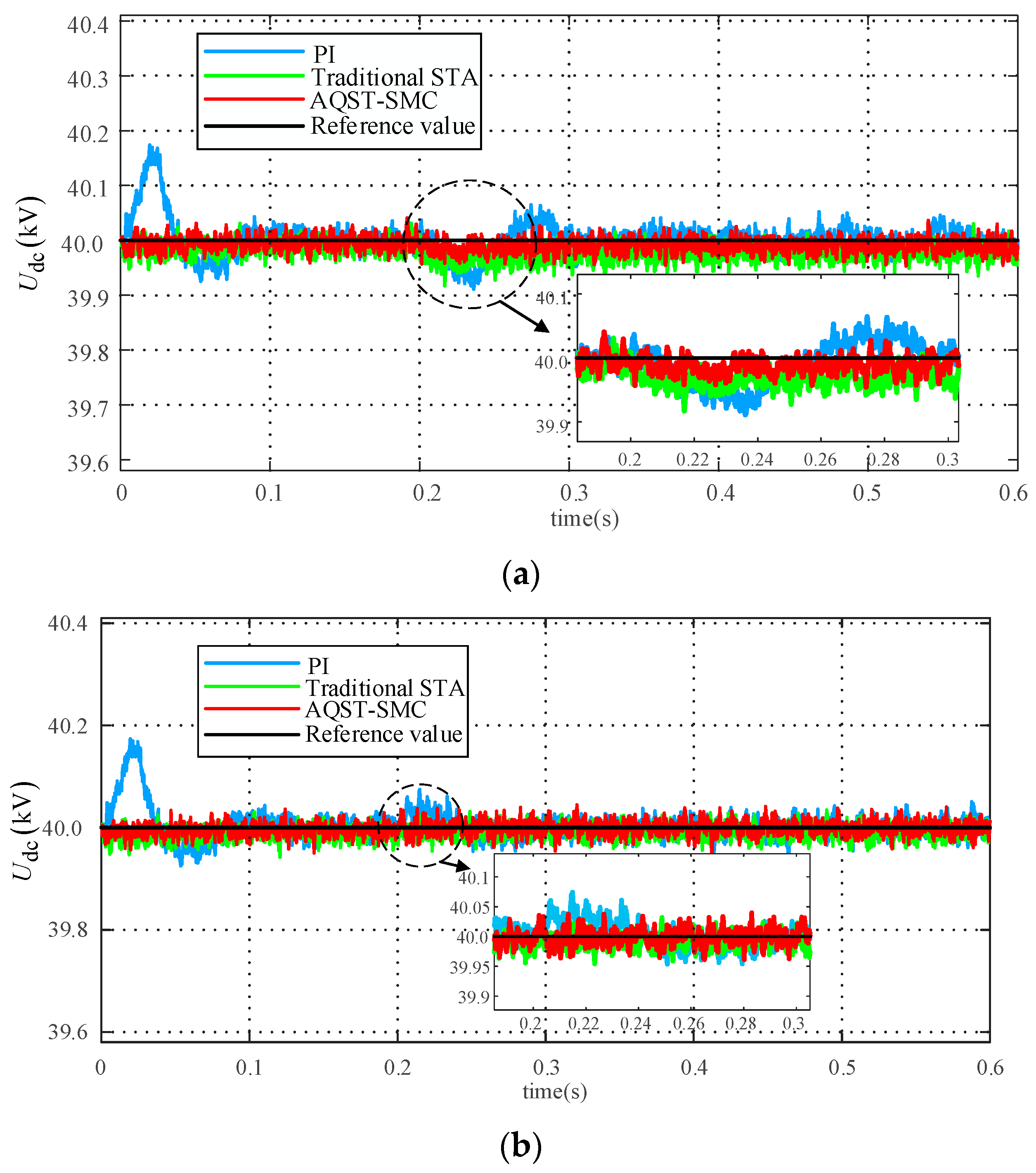

| System Parameter | Symbol | Value |
|---|---|---|
| AC voltage rating | us | 10 kV |
| AC side-rated frequency | fs | 50 Hz |
| Rated port capacity | S | 10 MVA |
| DC voltage reference | Udc | 40 kV |
| Submodule point capacitance | C | 5000 μF |
| Bridge arm inductance | L0 | 2 mH |
| Number of sub-modules | N | 20 |
| Control Modes | Response Time (ms) | Adjustment Time (ms) | Steady-State Oscillation Amplitude |
|---|---|---|---|
| First-order SMC | P: 4.30 | P: 3.95 | P: 9.87% |
| Q: 5.50 | Q: 4.40 | Q: 8.91% | |
| Traditional STA | P: 1.00 | P: 1.20 | P: 6.96% |
| Q: 1.23 | Q: 1.00 | Q: 8.36% | |
| AQST-SMC | P: 0.51 | P: 0.32 | P: 4.64% |
| Q: 0.47 | Q: 0.30 | Q: 5.03% |
| Control Method | Parameters of Outer Loop Controller | Parameters of Inner Loop Controller |
|---|---|---|
| Traditional PI (MMC 1) | kp1 = 0.5, ki1 = 100 | kp1 = 22, ki1 = 3.46 |
| Traditional PI (MMC 2) | kp2 = 0.00005, ki2 = 70 | kp2 = 22, ki2 = 3.46 |
| Traditional PI (MMC 3) | kp3 = 0.000028, ki3 = 80 | kp3 = 22, ki3 = 3.46 |
| First-Order SMC | ε = 1, q = 40, c1 = 30, Δ = 0.05 | ε = 3, q = 4000, c1 = 30, Δ = 0.05 |
| AQST-SMC | α1 = 2, β1 = 30, k1 = 10 | α1 = 110,000, β1 = 20,000, k1 = 10 |
Disclaimer/Publisher’s Note: The statements, opinions and data contained in all publications are solely those of the individual author(s) and contributor(s) and not of MDPI and/or the editor(s). MDPI and/or the editor(s) disclaim responsibility for any injury to people or property resulting from any ideas, methods, instructions or products referred to in the content. |
© 2024 by the authors. Licensee MDPI, Basel, Switzerland. This article is an open access article distributed under the terms and conditions of the Creative Commons Attribution (CC BY) license (https://creativecommons.org/licenses/by/4.0/).
Share and Cite
Ma, W.; Wang, X.; Wang, Y.; Zhang, W.; Li, H.; Zhu, Y. Adaptive Quasi-Super-Twisting Sliding Mode Control for Flexible Multistate Switch. Energies 2024, 17, 2643. https://doi.org/10.3390/en17112643
Ma W, Wang X, Wang Y, Zhang W, Li H, Zhu Y. Adaptive Quasi-Super-Twisting Sliding Mode Control for Flexible Multistate Switch. Energies. 2024; 17(11):2643. https://doi.org/10.3390/en17112643
Chicago/Turabian StyleMa, Wenzhong, Xiao Wang, Yusheng Wang, Wenyan Zhang, Hengshuo Li, and Yaheng Zhu. 2024. "Adaptive Quasi-Super-Twisting Sliding Mode Control for Flexible Multistate Switch" Energies 17, no. 11: 2643. https://doi.org/10.3390/en17112643
APA StyleMa, W., Wang, X., Wang, Y., Zhang, W., Li, H., & Zhu, Y. (2024). Adaptive Quasi-Super-Twisting Sliding Mode Control for Flexible Multistate Switch. Energies, 17(11), 2643. https://doi.org/10.3390/en17112643







